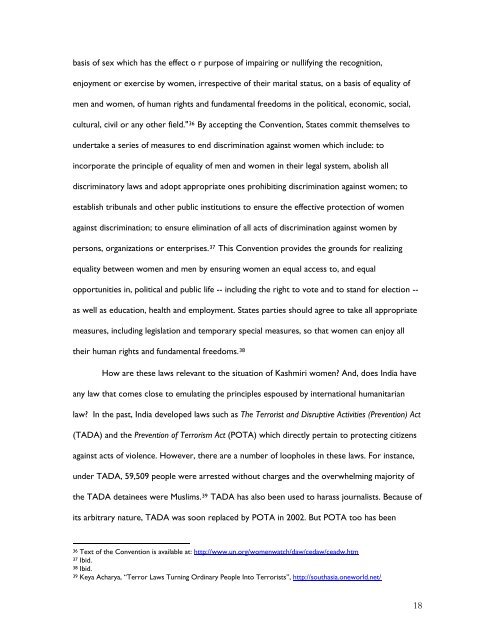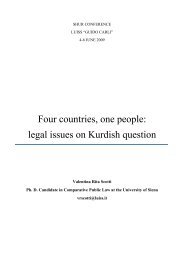The Kashmiri Woman: Identity and Politics - SHUR - Luiss
The Kashmiri Woman: Identity and Politics - SHUR - Luiss
The Kashmiri Woman: Identity and Politics - SHUR - Luiss
Create successful ePaper yourself
Turn your PDF publications into a flip-book with our unique Google optimized e-Paper software.
asis of sex which has the effect o r purpose of impairing or nullifying the recognition,<br />
enjoyment or exercise by women, irrespective of their marital status, on a basis of equality of<br />
men <strong>and</strong> women, of human rights <strong>and</strong> fundamental freedoms in the political, economic, social,<br />
cultural, civil or any other field." 36 By accepting the Convention, States commit themselves to<br />
undertake a series of measures to end discrimination against women which include: to<br />
incorporate the principle of equality of men <strong>and</strong> women in their legal system, abolish all<br />
discriminatory laws <strong>and</strong> adopt appropriate ones prohibiting discrimination against women; to<br />
establish tribunals <strong>and</strong> other public institutions to ensure the effective protection of women<br />
against discrimination; to ensure elimination of all acts of discrimination against women by<br />
persons, organizations or enterprises. 37 This Convention provides the grounds for realizing<br />
equality between women <strong>and</strong> men by ensuring women an equal access to, <strong>and</strong> equal<br />
opportunities in, political <strong>and</strong> public life -- including the right to vote <strong>and</strong> to st<strong>and</strong> for election --<br />
as well as education, health <strong>and</strong> employment. States parties should agree to take all appropriate<br />
measures, including legislation <strong>and</strong> temporary special measures, so that women can enjoy all<br />
their human rights <strong>and</strong> fundamental freedoms. 38<br />
How are these laws relevant to the situation of <strong>Kashmiri</strong> women? And, does India have<br />
any law that comes close to emulating the principles espoused by international humanitarian<br />
law? In the past, India developed laws such as <strong>The</strong> Terrorist <strong>and</strong> Disruptive Activities (Prevention) Act<br />
(TADA) <strong>and</strong> the Prevention of Terrorism Act (POTA) which directly pertain to protecting citizens<br />
against acts of violence. However, there are a number of loopholes in these laws. For instance,<br />
under TADA, 59,509 people were arrested without charges <strong>and</strong> the overwhelming majority of<br />
the TADA detainees were Muslims. 39 TADA has also been used to harass journalists. Because of<br />
its arbitrary nature, TADA was soon replaced by POTA in 2002. But POTA too has been<br />
36 Text of the Convention is available at: http://www.un.org/womenwatch/daw/cedaw/ceadw.htm<br />
37 Ibid.<br />
38 Ibid.<br />
39 Keya Acharya, “Terror Laws Turning Ordinary People Into Terrorists”, http://southasia.oneworld.net/<br />
18



